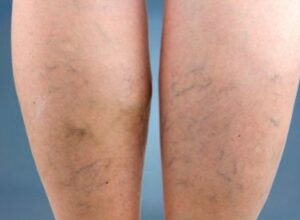If you’ve ever suffered from varicose veins or spider veins, you know that not only are they unsightly, but that they could point to a more serious underlying medical issue known as venous insufficiency.
Read on to know more about the differences between varicose veins and spider veins.
Which Is Which and What Are They Exactly?
Spider veins are the clusters of blue or black veins that appear in your lower legs. Varicose veins are the larger, more bulged out veins.
In general, spider veins tend to be cosmetic, while varicose veins point to a possibly pernicious level of venous insufficiency.
 Venous insufficiency refers to when the valves in your veins are damaged. Veins have to work very hard to pump blood back to the heart because they work against gravity. Therefore, if anything damages the valves, blood can backflow and pool up in your veins–leading to the engorged appearance of spider veins and varicose veins.
Venous insufficiency refers to when the valves in your veins are damaged. Veins have to work very hard to pump blood back to the heart because they work against gravity. Therefore, if anything damages the valves, blood can backflow and pool up in your veins–leading to the engorged appearance of spider veins and varicose veins.
There is no single pathology for why venous insufficiency might occur–it could be due to aging, it could be simply hormonal, or it may stem from other causes.
Should I Get These Treated?
Even if you don’t mind the cosmetic appearance of spider veins or varicose veins, it’s worth considering getting these conditions treated if you suffer from any of the signs of venous insufficiency.
The signs you might have venous insufficiency include achy or burning legs, or a general feeling of tiredness in your lower body. If venous insufficiency progresses to a more advanced stage, you may develop sores or skin ulcers in your lower extremities, and wounds may be unable to heal due to chronic backing up of blood.
If you’re interested in treating spider veins or varicose veins with a permanent solution, sclerotherapy is the conventional option.
If you want to know more, call the Vein Center of Maryland to schedule an appointment. We are conveniently located in Westminster, Eldersburg, Baltimore, Hunt Valley and Bel Air.
We also service Ellicott City and Columbia in Howard County.

